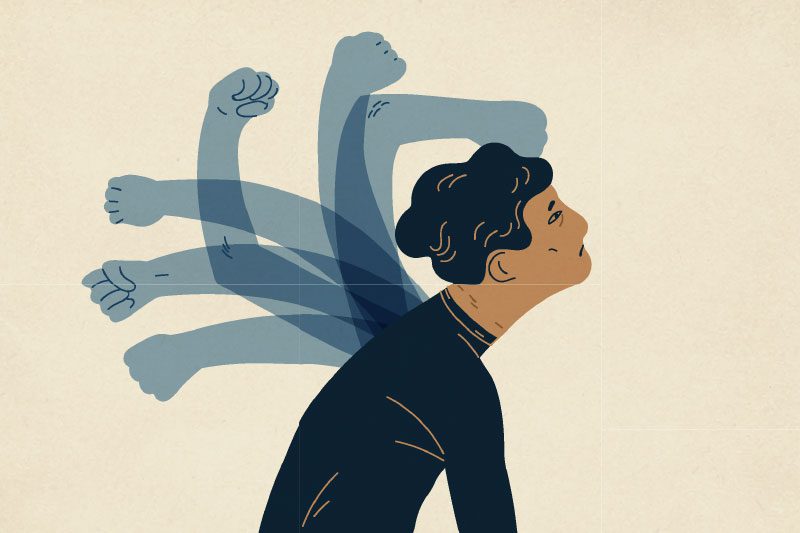By Hailey Shafir, LPCS, LCAS, CCS-I
If someone asked you to list five words that describe you, what words come to mind? Most people, when asked this question, arrive at a cherry-picked bunch of qualities such as “creative” or “funny” or “kind.” You would probably base the list off a series of parameters like wanting the list to be honest but not too honest, favorable but not arrogant, and relevant to the person and context in which the question is asked.
Having these parameters or arriving at the words you did doesn’t make you dishonest or manipulative, but for many of you, may reflect a stark contrast between the words used to describe yourself to others versus the words used in the private inner dialogue of your thoughts. Think of it this way, if someone were to scan an unedited “transcript” of your thoughts for an entire day, how many times would the five words you chose show up in thoughts you have about yourself?
Thoughts are powerful. They influence how you feel, how you perceive your experiences, and how you arrive at each choice you make, big or small. Thoughts you have about yourself, or the words you use to describe yourself, your actions, and the impact of these actions, are especially important.
Often, the words in private inner thoughts are far less kind than those you would say aloud to others. This is especially true when people make mistakes, are insecure, or worried about something that has already happened or could happen in the future. During these times, your private inner dialogue might be infiltrated by a more negative voice – the voice of your inner critic.
Your inner critic
Your “inner critic” is a part of your mind that identifies problems, flaws, and mistakes. It seems to prey on your most vulnerable insecurities, and it can be relentless in the way it spotlights flaws, replays mistakes, places blame, and forecasts bad outcomes that may come because of these.
For some, this inner critic is only active during certain stressful times in life, but for others, the experience is much more frequent and can even become so hostile that people begin feeling as though they are in an abusive relationship with themselves. Many people come to therapy because of the effects of some of these self-critical thoughts, which can contribute to problems such as low self-esteem, shame, anxiety, and depression.
Often, when people become aware of their inner critic and the damage it has done, they can be quick to label the critic as the “enemy” they have to fight and defeat. They might try to fight their critic with positive affirmations, working to replace critical thoughts with positive thoughts. Sometimes this works, and other times it does not.
In some cases, they might find that for every argument against a critical thought they have, there is a counter-argument, a “yeah, but” or “what about that time when,” leading to an endless inner debate that can leave some feeling frustrated, exhausted, and sometimes even more stuck.
Here is a question for any readers who can relate to this experience: What if you could get your critic on your side, getting it to work for you, instead of against you? After all, powerful enemies can also make powerful allies.
How your critic works
Your inner critic is the part of your mind responsible for critical thinking, which is an essential tool you use every day. The critical part of your mind is the part that finds problems and flaws, but it is also the part that helps make decisions and solve problems. Your critic has probably been involved in every goal you have set and reached and every key decision you made, which changed the course of your life for the better. Each time you have grown, your critic has been working for you.
Your critic’s intentions are usually to help you, even though it might not feel like it. Typically, the critic is the loudest when you have made a mistake or are worried. It senses your concern and wants to help protect against failure or rejection. The problem is that the “help” it provides in these situations is often not helpful.
Getting your critic to help in ways that are helpful requires an understanding of the way this part of your mind works. Your critic works to help solve problems with a specific process. This process is to:
- Zoom in on the problem
- Analyze the source or cause of the problem
- Present options for how to move forward
This formula works for solving a range of problems like balancing your budget, getting a health problem diagnosed and treated, or finding a way to fit something into a busy schedule. The formula begins to break down under certain conditions, including when you have strong emotions, or you are too focused on a personal trait, or when you give it unsolvable problems – like ones that have already happened, have not happened yet, or will happen because of things beyond your control.
Under these conditions, your critic becomes unhelpful, getting stuck in the first or second step of the problem-solving process. When the critic gets stuck in the first step of “zooming in,” the emotion or insecurity becomes magnified, which probably makes you more emotional.
Someone who is anxious will likely become more anxious when zooming in on anxious thoughts or feelings, and someone who is sad might get stuck on bad things that have happened to them. In this way, the critic is unhelpful because it gets you more deeply stuck in unhelpful thoughts. When the critic gets stuck in the second step, which is analyzing to find the cause of the problem, it often gets personal, blaming something about you or what you did wrong. For example, the critic might be trying to find a reason why a relationship ended and come up with a list of personal flaws and mistakes.
Redirect your critic
When you catch your inner critic getting stuck, it is important to recognize what is happening and redirect your critic. The types of problems the critic is best at solving are ones which are:
- Specific vs general: Identifying a certain part of your house that you want to improve vs your entire house
- Objective vs personal: Identifying ways to be more active instead of focusing on being less lazy
- Logistical vs emotional: Focusing on how to respond better to anxiety rather than get rid of it entirely
- Present tense vs past or future-tense: Focusing on how to save money now instead of whether social security will be around
- Known vs uncertain or unknown: Focusing on how to showcase your experience vs the experience of others applying for the job
- Actionable vs unactionable: Focusing on how to present material in an interesting way instead of on how to be more interesting in general
Sometimes a “solution” is not possible, and the best result of the problem-solving process is choosing the best response to a situation. For example, a person is not able to change that something bad has happened to someone they love, but they are able to offer help or support to that person, which might be the best response to the situation. Using these guidelines, it is often possible to interrupt unhelpful self-criticisms and put your critic to work in new, more helpful ways.
Your critical mind is a tool, and all tools can be either helpful or destructive, depending on how they are used. Your critic wants to help you solve problems and make choices that help you reach your goals, protecting you against the things that might get in the way. It just doesn’t always offer the right kind of help, and it needs patient leadership from you on what to do and how to get started.
Assigning your critic the right kinds of jobs and redirecting when it gets sidetracked will help you utilize this powerful tool to help build the things you most want in life, avoiding potential destruction.





